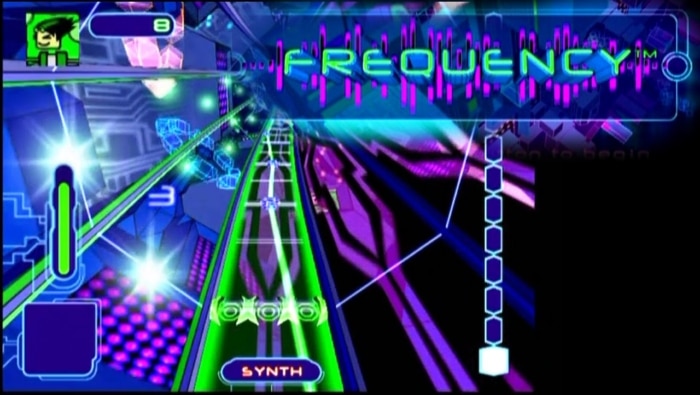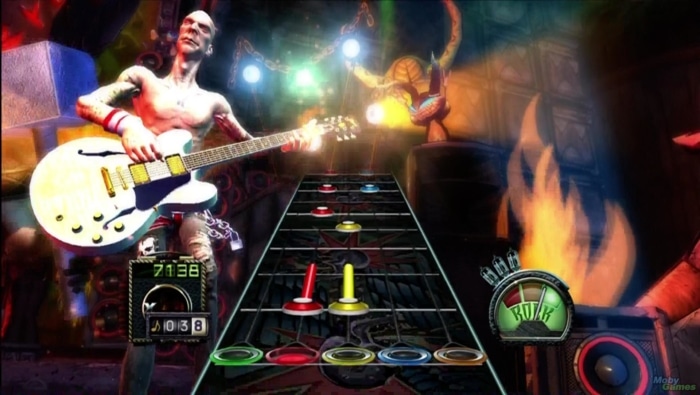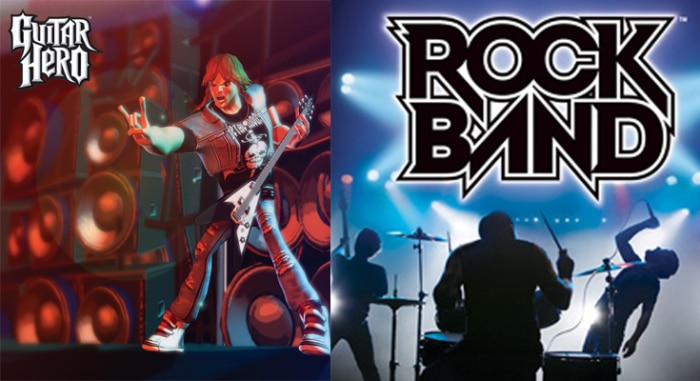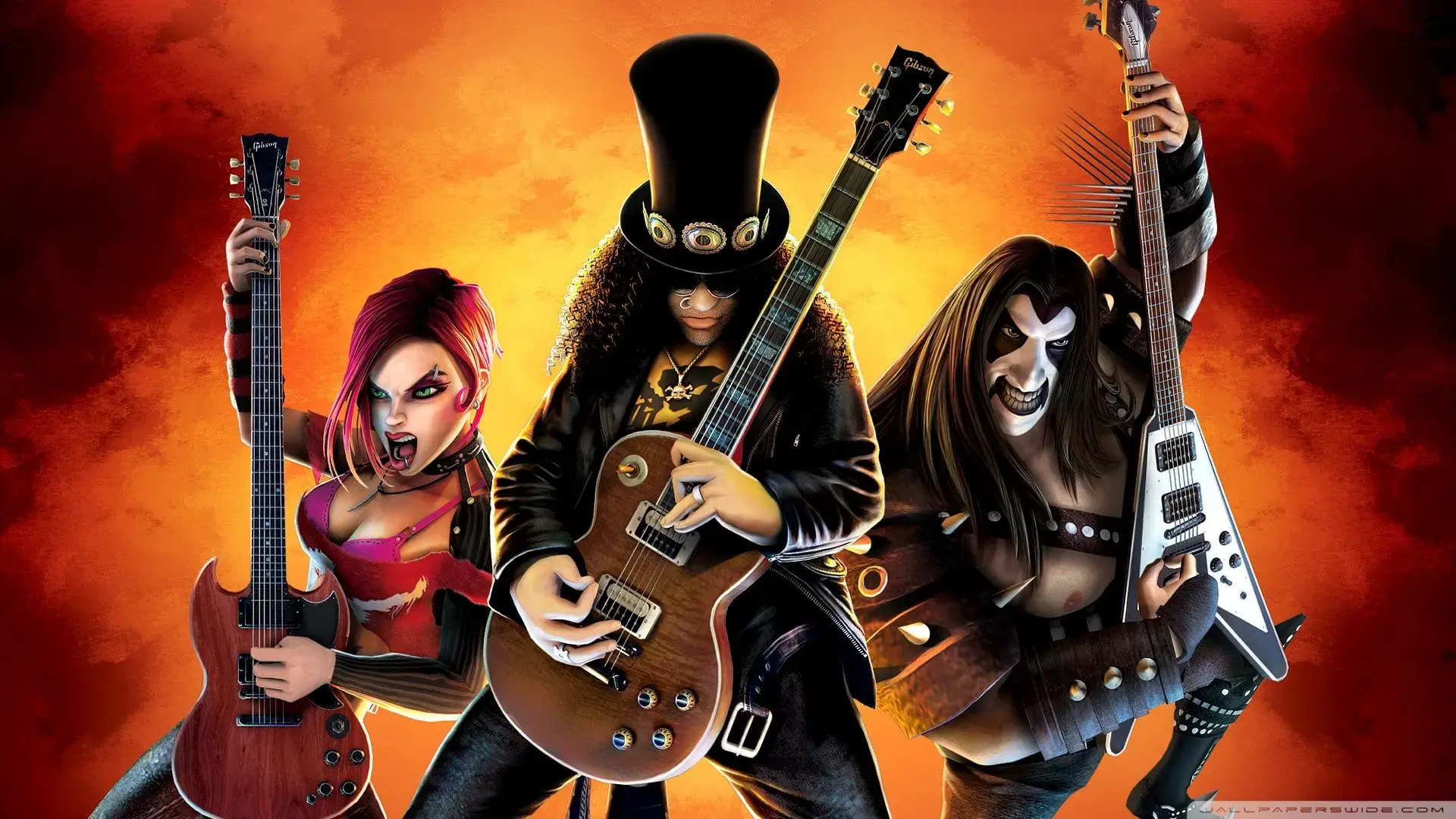Story of a Game: Guitar Hero
Games have stories. Not just stories of how they were developed, but stories from the people that played them and the way they affected the gaming world.
In this series, Ultimate Gaming Paradise is going to bring you some of these stories, from headline-making triple-A titles to indie masterpieces.
Put on a denim jacket, slap on some make-up and pick up your axe—it’s time to rock with Guitar Hero.
It’s All About the Rhythm
It’s rare for a new genre of computer game to evolve. Many of the known ways to get a computer to be entertaining were well established by the turn of the century. The 70s and 80s were the eras of high concepts and the birth of IPs. The early 90s solidified expectations and provided polish. By the time 1995 came along, the general consensus was that everything that was going to be done had been done.
Enter PaRappa the Rapper, a strange little game for the PlayStation that came out in 1996 and had people talking. What was it? The first successful rhythm game, where you had to press buttons in time with the music in the background. Time your hammering and you are rewarded, flop about like a soulless fish out of water and you are ridiculed.
It was a huge hit and opened the door for something truly special.
Singing, Dancing, Drumming and Air Guitar
In the wake of the hugely successful success of PaRappa the Rapper, music-based games surged. Dance Dance Revolution (DDR)—an arcade hit where you step on coloured squares in time to the music to perform a dance (and get sweaty while you do) stormed the world—was big in Japan and led to various spin-offs, including a drumming game and a guitar-playing experience called Guitar Freaks.
In order to make these arcade games work, the cabinets came with customised controllers. For DDR, it was the pads on the floor. Real-life Karaoke had microphones, and Guitar Freaks had a strange three-button guitar.

The impact in the West was a little less impressive than in Japan.
Meanwhile…
Music Lovers Write Software
Two MIT graduates, Alex Rigopulos and Eran Egozy, were determined to bring music to the world. They were working on music systems with a desire to give music to everyone—even those with very little talent.
They believed that the technology was getting to a point where it could help people create music, even if they didn’t have the skills (or determination) to learn an instrument.
The two were convinced there was a universal truth “which is that just about everyone is born loving music and they’re born with this innate desire to make music, and just about everyone tries at some point in their lives to learn to play an instrument or learn to make music,” stated Rigopulos, co-founder and CEO of Harmonix.
But there were problems.
They discovered that people started learning an instrument only to give up after hitting the inevitable hurdles along the way. Learning something like the guitar, piano, or violin takes perseverance and a lot of time to dedicate to it in order to become any good–attributes that simply not everyone has.
So they created Harmonix with the intention of using computer software to bridge the gap. It led to a pseudo-game called The Axe.
Finding the Right Mix
The Axe suffered, somewhat ironically, with the fact that though people enjoyed fiddling with it for a few minutes, they eventually gave up. Rather than become the ground-breaking musical creation tool they hoped, it was something of an oddity—interesting for half an hour or so and then quickly forgotten.
Undeterred, Harmonix pushed on with developing their software but more of a gaming edge. They produced a rhythm-style game of their own: Frequency (PS2, 2001). It sold a little but did nothing particularly special.
Meanwhile (again)…
Selling Peripherals
Another company, RedOctane, had found some success selling their own version of the dance mats for DDR. While there was interest in the game in the US, Konami was only supplying the software, which meant it had to be played with a standard controller—hardly recreating the sweat-filled arcade experience.
Spying this gap in the market, RedOctane designed and sold its own dance mats. Unofficial, perhaps, but good enough to mean they were in great demand by DDR fans across the States. Bosses at RedOctane had their eyes on expanding that business. What if they could bring Guitar Freaks and the various drum games to the US?
Or even better, what if they could make their own game?

Coming Together
Eventually, Harmonix and RedOctane met and agreed to work together. Both small companies with relatively small amounts of money, their game would be low-budget and probably only sell a few copies—but it was something they were all passionate about creating. Harmonix had been thinking about it for a while and even had a name in mind: Guitar Hero.
The Origins of Guitar Hero
Harmonix was a company of musicians as much as it was programmers. In fact, that was so considered the culture that prospective coders didn’t bother applying to work at the studio if they weren’t musically minded. Everyone there was in a band, and they were all passionate and opinionated about the music they liked.
The game they envisioned was karaoke for guitars, an extension of the work they had done with Frequency. It would put that rockstar feeling into the hands of every mirror-gazing, air-guitar playing teenager–and this was an exciting proposal.
Surely it would work, even though the common wisdom was against them: after all, music games hadn’t worked in the past, and games that needed their own expensive peripherals were typically dead on arrival. Given that, Guitar Hero was bound to be a success, right?
Hmm…
Making a Game Designed to ROCK!
The Japanese game Guitar Freaks was, essentially, pretty boring. The visuals on screen were a 2D representation of the music, and the type of music on offer was bland pop. Harmonix wanted something different—they wanted to rock!
With a company made up of musicians, making a prototype to hook in the prospective investors wasn’t too hard. They already had a working rhythm game in Frequency, and adapting that code to make the bare bones of what was to become Guitar Hero only took a week or so. Before too long, they were presenting a game that everyone was immediately excited about. Well-known riffs and loud guitars meant that people took to those early demos with enthusiasm, even before there was a guitar controller.
Soon they were on their way. While the art team worked on bringing 80s-style big-hair rockers to life, the people at RedOctane were trying to secure licenses for the vast spread of songs that were being discussed as the playlist.
And it was vast! Everyone had their own opinion on what should go on in the final game, and knowing they wouldn’t get the rights for everything they wanted, a longer list was far better than a short one.
Getting those rights was hard. The big boys—bands like Metallica, AC/DC and Led Zeppelin—had no interest in putting their name to the fledgling game, and conversations had to be hard with record companies and bands alike. In the end, they succeeded in securing a full selection…of covers.
The skills of the WaveGroup musicians–brought in to reproduce the songs for the game–were so good that many people believed they were the original songs. In fact, the very first Guitar Hero only had covers for the main game (30 songs in all) and then 17 bonus songs from minor, generally unknown groups. The rights to original songs were acquired at a later stage as the game grew in popularity.
All the big-name songs were performed by WaveGroup specifically for the game, with adjustments made in some sections to make the guitar lines fit the system.
Of course, none of this would work without a brilliant controller.
Relying on a Peripheral
Games that come with their own peripherals tend to die. As a whole, players don’t want to fill their bedrooms or living rooms with an assortment of plastic tat that’s only used for one or two games. Despite knowing this, RedOctane and Harmonix were convinced they could get it right.

An initial decision to put five buttons on the guitar was key. Early ideas had it at only three or four buttons, making the game accessible for beginners. The advancement of a fifth button on the fret—which you had to stretch to reach—made the experience feel a lot more like playing a real guitar. Developers saved that tricky fifth button for people willing to ramp the difficulty up to expert, with lower difficulties only utilising three or four of the buttons. This way, they managed to make a controller that suited both ends of the skill spectrum. Add to that the whammy bar to play personal touches and the ‘lift the guitar for star power’ additional feature, and the guitar provided some great moments that could never have been replicated with a standard PS2 controller.
Nonetheless, it was a hard sell. The big bulky guitar meant the box was huge and the game expensive. Selling it to retailers used to sticking console games in lines on shelves was tough. Not everyone went for it. Not at first, perhaps, but once the sales started coming in, opinions changed quickly.
Luckily, the first decade of the 21st century saw a change in players’ acceptance of additional peripherals in gaming. Nintendo’s Wii console was guilty of utilising way too much plastic for ‘realistic’ controllers and the Wii Fit Board. Sony and Microsoft were developing camera and VR-based technologies–with steering wheels for realistic driving gaming and arcade-like fighting sticks for one-on-one battles. Coming early in the storm, it could be that Guitar Hero’s controller made a pathway for all of that—a gaming zeitgeist like no other.
Releasing Guitar Hero into the Wild
Guitar Hero had to be played to be understood. More expensive than the other games and shunted to the side in shops, the game relied on its addictive playability to reach an audience.
Its debut was in Los Angeles at E3 2005, where players were invited to have a go in a booth behind closed curtains. Word of mouth quickly spread, and soon everyone was queueing for the opportunity. This was a game like no other, one that had to be seen and experienced to be believed.
The same was true in people’s homes. Those willing to shell out for this new game soon found that their living rooms became the location for a new type of party. Guitar Hero crossed the traditional boundary between gamer and non-gamer, making it fun for everyone. It was seen as less of a computer game and more of a social music experience. Even though only two players could simultaneously have a go, there would be a crowd around them, cheering and singing along while waiting for their turn at the axe.
Demos in game shops were everywhere, and kids who hadn’t yet saved up enough to buy it were spending their Saturday afternoons hovering around and hoping for another go.
And where Guitar Hero was seen, it was loved.
Making Superstars
The legacy of Guitar Hero is also impressive. Aside from the various subsequent titles that came from those beginnings, it brought new bands to a keen audience thanks to the 17 original bonus songs. It also made YouTube stars of those regular people willing to put their performances out there (injuries and all).
The bands themselves even played it. The Killers, whose song When We Were Young appears on the second game in the series, were great Guitar Hero fans, playing it in their tour bus while out on the road.
Somewhat amusingly, other artists have been videoed trying out their own songs, to varying degrees of success—after all, you would, wouldn’t you?
Buy-outs, Success and Crashing
Guitar Hero was a success on a scale that both RedOctane and Harmonix could never have expected. Demand was so high that they couldn’t keep up. While they waited for the cash from 60-day sales invoices to come in, they had to remortgage their houses to buy in more stock. Plus, without a prior infrastructure in place, entire weeks were spent doing nothing but hand-packing boxes to distribute to eager shops.
A game that they expected to sell a few thousand of passed $45 million in revenue in the first two months.
It tore the partnership apart. Soon Activision came knocking on RedOctane’s door, while MTV’s Viacom did the same for Harmonix. Contracts were signed, money changed hands, and the working relationship between the two small companies died, consumed by their corporate owners. It seemed that prior events, unknown to any of the Guitar Hero teams, meant that Activision refused to work with Viacom.

After completing Guitar Hero 2 and an expansion pack to fulfil their contract, Harmonix went on to develop the Rock Band series for their new partners. Finally, it was a chance to add drums, keyboards and vocals to the experience, something Harmonix had wanted to do. RedOctane worked on the Guitar Hero series with other developers but never quite managed to recapture the magic that made the original so beloved.
A few years later, the world moved on. Despite technologically superior wireless controllers, bigger lists of bands offering their original material, and what seems like a million spin-off products, both Guitar Hero and Rock Band have long since died. Playing the games today requires finding the original equipment and setting it all up like it’s 2005.
It is worth doing, though!

